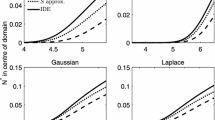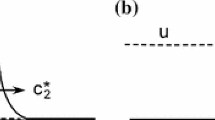Abstract
Simplified conditions are given for the existence and positivity of wave speed for an integro-difference equation with a strong Allee effect and an unbounded habitat. The results are used to obtain the existence of a critical patch size for an equation with a bounded habitat. It is shown that if the wave speed is positive there exists a critical patch size such that for a habitat size above the critical patch size solutions can persist in space, and if the wave speed is negative solutions always approach zero. An analytical integral formula is developed to determine the critical patch size when the Laplace dispersal kernel is used, and this formula shows existence of multiple equilibrium solutions. Numerical simulations are provided to demonstrate connections among the wave speed, critical patch size, and Allee threshold.






Similar content being viewed by others
References
Allee WC, Emerson AE, Park O, Park T, Schmidt KP (1949) Principles of animal ecology. W. B Saunders, Philadelphia
Calabrese JM, Fagan WF (2004) Lost in time, lonely, and single: reproductive asynchrony and the Allee effect. Am Nat 164:25–37
Courchamp F, Berec L, Gascoigne J (2008) Allee effects in ecology and conservation. Oxford University Press, London
Davis HG, Taylor CM, Lambrinos JG, Strong DR (2004) Pollen limitation causes an Allee effect in a wind-pollinated invasive grass (Spartina alterniflora). Proc Natl Acad Sci USA 101:13804–13807
Hardin DP, Takac P, Webb GF (1988) Asymptotic properties of a continuous-space discrete-time population model in a random environment. Bull Math Biol 26:361–374
Hardin DP, Takac P, Webb GF (1988) Dispersion population models discrete in time and space. J Math Biol 28:1–20
Hastings A, Higgins K (1994) Persistence of transients in spatially structured ecological models. Science 263:1133–1136
Hsu S-B, Zhao X-Q (2008) Spreading speeds and traveling waves for nonmonotone integrodifference equations. SIAM J Math Anal 40:776–789
Kot M (1992) Discrete-time traveling waves: ecological examples. J Math Biol 30:413–436
Kot M (2001) Elements of mathematical ecology. Cambridge University Press, Cambridge
Kot M, Schaffer WM (1986) Discrete-time growth-dispersal models. Math Biosci 80:109–136
Kot M, Lewis MA, van der Driessche P (1996) Dispersal data and the spread of invading species. Ecology 77:2027–2042
Lewis ML, Marculis NG, Shen W (2018) Integrodifference equations in the presence of climate change: persistence criterion, travelling waves and inside dynamics. J Math Biol 77:1649–1687
Li B, Lewis MA, Weinberger HF (2009) Existence of traveling waves for integral recursions with nonmonotone growth functions. J Math Biol 58:323–338
Li B, Bewick S, Barnard MR, Fagan WF (2016) Persistence and spreading speeds of integro-difference equations with an expanding or contracting habitat. Bull Math Biol 78:1337–1379
Li B, Wu J (2020) Traveling waves in integro-difference equations with a shifting habitat. J Diff Eqs 268:4059–4078
Li B, Zhang M, Coffman B (2020) Can a barrier zone stop invasion of a population? J Math Biol 81:1193–1216
Ludwig D, Aronson DG, Weinberger HF (1979) Spatial patterning of the spruce budworm. J Math Biol 8:217–258
Lui R (1982) A nonlinear integral operator arising from a model in population genetics. I. Monotone initial data. SIAM J Math Anal 13:913–937
Lui R (1982) A nonlinear integral operator arising from a model in population genetics. II. Initial data with compact support. SIAM J Math Anal 13:938–953
Lui R (1983) Existence and stability of traveling wave solutions of a nonlinear integral operator. J Math Biol 16:199–220
Lustig A, Worner SP, Pitt JPW, Doscher C, Stouffer DB, Senay SD (2017) A modeling framework for the establishment and spread of invasive species in heterogeneous environments. Ecol Evol 7:8338–8348
Lutscher F (2019) Integrodifference equations in spatial ecology. Springer, Berlin
McGahan I, Powell J, Spencer E (2021) 28 models later: model competition and the zombie apocalypse. Bull Math Biol 83:22
Parker IM (2004) Mating patterns and rates of biological invasion. Proc Natl Acad Sci USA 101:13695–13696
Pouchol C, Trélat E, Zuazua E (2019) Phase portrait control for 1D monostable bistable reaction-diffusion equations. Nonlinearity 32:884–909
Slatkin M (1973) Gene flow and selection in a cline. Genetics 75:733–756
Sullivan LL, Li B, Miller TEX, Neubert MG, Shaw AK (2017) Density dependence in demography and dispersal generates fluctuating invasion speeds. Proc Natl Acad Sci USA 114:5053–5058
Taylor CM, Hastings A (2005) Allee effects in biological invasions. Ecol Lett 8:895–908
Veit RR, Lewis MA (1996) Dispersal, population growth and the Allee effect: dynamics of the House Finch invasion of eastern North America. Am Nat 148:255–274
Wang MH, Kot M, Neubert MG (2002) Integrodifference equations, Allee effects, and invasions. J Math Biol 44:150–168
Weinberger HF (1978) Asymptotic behavior of a model in population genetics. In: Chadam JM (ed) Nonlinear partial differential equations and applications. Lecture notes in mathematics, vol 648. Springer, Berlin, pp 47–96
Weinberger HF (1982) Long-time behavior of a class of biological models. SIAM J Math Anal 13:353–396
Weinberger HF, Zhao XQ (2010) An extension of the formula for spreading speeds. Math Biosci Eng 7:187–194
Wheeden RL, Zygmund A (1977) Measure and integral: an introduction to real analysis. Marcel Dekker, Inc., New York
Zhou Y, Kot M (2011) Discrete-time growth-dispersal models with shifting species ranges. Theor Ecol 4:13–25
Author information
Authors and Affiliations
Corresponding author
Additional information
Publisher's Note
Springer Nature remains neutral with regard to jurisdictional claims in published maps and institutional affiliations.
B. Li was partially supported by the National Science Foundation under Grant DMS-1951482.
Rights and permissions
Springer Nature or its licensor (e.g. a society or other partner) holds exclusive rights to this article under a publishing agreement with the author(s) or other rightsholder(s); author self-archiving of the accepted manuscript version of this article is solely governed by the terms of such publishing agreement and applicable law.
About this article
Cite this article
Li, B., Otto, G. Wave speed and critical patch size for integro-difference equations with a strong Allee effect. J. Math. Biol. 85, 59 (2022). https://doi.org/10.1007/s00285-022-01814-3
Received:
Revised:
Accepted:
Published:
DOI: https://doi.org/10.1007/s00285-022-01814-3




